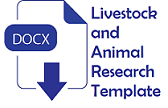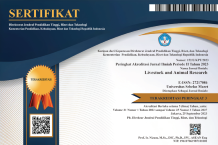Complete feed of corn silage and its effect on male Bali cattle performance, feed consumption, and beef quality
Abstract
Objective: This study aims to observe the effect of feeding corn silage combined with elephant grass and cheap concentrate feed on male Bali cattle performance, feed consumption, and beef quality.
Methods: Animal feed testing was performed in male Bali cattle weighing 150-200 kg for 90 days, and the cattle were slaughtered in a slaughterhouse to observe the beef quality. This study employed a completely randomized design with 4 treatments and 3 replicates. Research treatment: The proportion of 30% corn silage + 60% elephant grass + 10% concentrate feed as A1; 50% corn silage + 40% elephant grass + 10% concentrate feed as A2; 70% corn silage + 20% elephant grass + 10% concentrate feed as A3; 100% corn silage as A4. The observed parameters in include average daily gain, dry matter consumption, organic matter consumption, crude protein consumption, total digestible nutrients, tenderness, beef color, water-holding capacity, cooking loss, and aroma.
Results: The results showed that the treatments significantly affect the consumption of dry matter with the highest A4 is 2.44% of body weight, organic matter with the highest A3 is 8.43 kg/head/day, crude protein with the highest A3 is 0.82 kg/head/day, and total digestible nutrients with the highest A3 is 4.88 kg/head/day. There is a significant difference in daily average weight gain (ADG) from the three treatments (P<0.05).
Conclusions: It can be concluded that A3 treatment, supplemented with 70% corn silage concentration, 20% elephant grass, and 10% concentrate feed is more effective in improving male Bali cattle performance, feed, consumption, and beef quality.
Keywords
Full Text:
PDFReferences
- Rusdy, M. 2016. Effects of agro-industrial byproduct on fermentation quality and nutritional composition of elephant grass (Pennisetum purpureum schum) silage. Livest. Res. Rural Dev. 28(12):0-06.
- Salendua, A. H. S., F. H. Elly, R. E. M. F. Osak, and I. D. R. Lumenta. 2018. Cattle farm development by forages cultivation on coconut land based on carrying capacity in West Bolangitang, Indonesia. Int. J. Environ. Agric. Biotechnol. 3(3):1139–1144. Doi: 10.22161/ijeab/3.3.54
- Hasan, S., S. Nompo, A. Mujnisa, Rinduwati, and S. Sema. 2020. The increase of corn crop productivity through NPK fertilizer addition in dy land. In: IOP Conference Series: Earth and Environmental Science. The 2nd International Conference & Workshop of Animal Science & Technology. Faculty of Animal Science Hasanuddin University. p. 012007I. Doi: 10.1088/1755-1315/492/1-/012007
- Pariz, C. M., N. R. Costa, C. Costa, C. A. C. Crusciol, A. M. de Castilhos, P. R. de L. Meirelles, J. C. Calonego, M. Andreotti, D. M. de Souza, I. V. Cruz, V. Z. Longhini, V. M. Protes, J. R. W. Sarto, M. L. S. de T. Piza, V. F. de P. Melo, R. C. Sereia, D. F. Fachiolli, F. A. de Almeida, L. G. M. de Souza, and A. J. Franzluebbers. 2020. An innovative corn to silage-grass-legume intercropping system with oversown black oat and soybean to silage in succession for the improvement of nutrient cycling. Front. Sustain. Food Syst. 4:544996. Doi: 10.3389/fsufs.2020.544996
- Beigh, Y. A., A. M. Ganai, and H. A. Ahmad. 2017. Prospects of complete feed system in ruminant feeding: A review. Vet. World. 10(4):424–437. Doi: 10.14202/-vetworld.2017.424-437
- Hasan, S., A. Mujnisa, P. I. Khaerani, Sema, and A. Natsir. 2020. Potential of complete feed formulated from local raw materials on beef cattle performance. EurAsian J. Biosci. 14(1):1–6.
- Kertz, A. F., M. K. Koepke, L. E. Davidson, N. L. Betz, J. R. Norris, L. V. Skoch, B. R. Cords, and D. T. Hopkins. 1982. Factors influencing intake of high urea-containing rations by lactating dairy cows. J. Dairy Sci. 65(4):587–604. Doi: 10.3168/jds.S0022-0302-(82)82236-4
- Van Seoest, P. 1994. Nutritional ecology of the ruminant. Cornell University Press, New York.
- Agus, A. and T. S. M. Widi. 2018. Current situation and prospect of beef cattle production in Indonesia — A review. Asian-Australasian J. Anim. Sci. 31(7):976. Doi: 10.5713/ajas.18.0233
- Erickson, P. S. and K. F. Kalscheur. 2020. Nutrition and feeding of dairy cattle. Anim. Agric. Sustain. Challenges Innov. 157–180. Doi: 10.1016/B978-0-12-817052-6.00009-4
- National Research Council. 1985. Ruminant nitrogen usage. Subcommittee on nitrogen usage in ruminants. Committee on animal nutrition. National Academy of Sciences. National Academy Press 2101 Constitution Avenue, NW. Washington, DC 20418.
- Warren, H. E., N. D. Scollan, M. Enser, S. I. Hughes, R. I. Richardson, and J. D. Wood. 2008. Effects of breed and a concentrate or grass silage diet on beef quality in cattle of 3 ages. I: Animal performance, carcass quality and muscle fatty acid composition. Meat Sci. 78(3):256–269. Doi: 10.1016/-j.meatsci.2007.06.008
- Hambrecht, E., J. J. Eissen, D. J. Newman, C. H. M. Smits, L. A. Den Hartog, and M. W. A. Verstegen. 2005. Negative effects of stress immediately before slaughter on pork quality are aggravated by suboptimal transport and lairage conditions. J. Anim. Sci. 83(2):440–448. Doi: 10.2527/2005.832440x
- Zhu, Z., Y. Chen, Z. Huang, Y. Zhang, Q. Xu, Y. Tong, F. Zhai, G. Chang, and G. Chen. 2014. Effects of transport stress and rest before slaughter on blood parameters and meat quality of ducks. Can. J. Anim. Sci. 94(4):595–600. Doi: 10.4141/CJAS-2014-017
- Huff-Lonergan, E. 2009. Fresh meat water-holding capacity. Improving the sensory and nutritional quality of fresh meat. 147-160.
- Lawrie, R. A., and D. Ledward. 2006. Lawrie’s Meat Science: Seventh Edition. Woodhead Publishing.
- Huffman, K. L., M. F. Miller, L. C. Hoover, C. K. Wu, H. C. Brittin, and C. B. Ramsey. 1996. Effect of beef tenderness on consumer satisfaction with steaks consumed in the home and restaurant. J. Anim. Sci. 74(1):91–97. Doi: 10.2527/1996.74191x
- Ngadiyono, N. 2000. Penampilan produksi sapi brahman cross jantan kastrasi pada berbagai lama waktu penggemukkan yang berbeda [Production performance of castrated male brahman cross in different period of fattening]. Bultetin Peternak. 24(2):68-75. Doi: 10.21059/buletinpeternak-.v24i2.1408
- Van Laack, R. L. J. M., C. H. Liu, M. O. Smith, and H. D. Loveday. 2000. Characteristics of pale, soft, exudative broiler breast meat. Poult. Sci. 79(7):1057–1061. Doi: 10.1093/ps/79.7.1057
- Timm, R. R., J. A. Unruh, M. E. Dikeman, M. C. Hunt, T. E. Lawrence, J. E. Boyer, and J. L. Marsden. 2003. Mechanical measures of uncooked beef longissimus muscle can predict sensory panel tenderness and Warner-Bratzler shear force of cooked steaks. J. Anim. Sci. 81(7):1721–1728. Doi: 10.2527/2003.8171721x
- Bekhit, A. E. D. A., J. D. Morton, Z. F. Bhat, and L. Kong. 2018. Meat color: Factors affecting color stability. In: Encyclopedia of Food Chem. 2:202-210
- Handayani, H. H., and A. F. N. Masruriyah. 2020. Determination of beef marbling based on fat percentage for meat quality. Int. J. Psychosoc. Rehabil. 24(7):8394–8401. Doi: 10.37200/IJPR/V24I7-/PR2700342
- Joo, S. T., G. D. Kim, Y. H. Hwang, and Y. C. Ryu. 2013. Control of fresh meat quality through manipulation of muscle fiber characteristics. Meat Sci. 95(4):828–836. Doi: 10.1016/j.meatsci.2013.04.044
- Suman, S. P., and P. Joseph. 2013. Myoglobin chemistry and meat color. Annu. Rev. Food Sci. Technol. 4(1):79–99. Doi: 10.1146/annurev-food-030212-182623
- Rosita, R., A. Husni, R. Riyanti, and D. Septinova. 2019. The effect of soaking beef in various concentration of ginger blend (Zingiber officinale roscoe) to ph, water holding capacity and cooking loss. J. Ris. dan Inov. Peternak. 3:31–37.
- Domiszewski, Z., G. Bienkiewicz, and D. Plust. 2011. Effects of different heat treatments on lipid quality of striped catfish (Pangasius hypophthalmus). Acta Sci. Pol. Technol. Aliment. 10(3):359–373.
- Ekiz, B., A. Yilmaz, M. Ozcan, C. Kaptan, H. Hanoglu, I. Erdogan, and H. Yalcintan. 2009. Carcass measurements and meat quality of Turkish Merino, Ramlic, Kivircik, Chios and Imroz lambs raised under an intensive production system. Meat Sci. 82(1):64–70. Doi: 10.1016/-j.meatsci.2008.12.001.
- Hidayat, M. A., K. Kuswati, and T. Susilawati. 2015. Pengaruh lama istirahat terhadap karakteristik karkas dan kualitas fisik daging sapi brahman cross steer [The effet of resting time length on the brahman cross steer carcass characteristics and beef physical quality]. J. Ilmu-Ilmu Peternak. 25(2):71–79. Doi: 10.21776/ub.jiip.2015.025.-02.09
Refbacks
- There are currently no refbacks.










